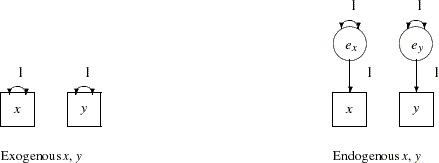| The CALIS Procedure |
| Exogenous Manifest Variables |
If there are exogenous manifest variables in the linear structural equation model, then there is a one-to-one relationship between the given covariances and corresponding estimates in the central model matrix ( or
or  ). In general, using exogenous manifest variables reduces the degrees of freedom since the corresponding sample correlations or covariances are not part of the exogenous information provided for the parameter estimation. See the section Counting the Degrees of Freedom for more information.
). In general, using exogenous manifest variables reduces the degrees of freedom since the corresponding sample correlations or covariances are not part of the exogenous information provided for the parameter estimation. See the section Counting the Degrees of Freedom for more information.
If you specify a RAM or LINEQS model statement, or if such a model is recognized in an INRAM= data set, those elements in the central model matrices that correspond to the exogenous manifest variables are reset to the sample values after computing covariances or correlations within the current BY group.
The COSAN statement does not automatically set the covariances in the central model matrices that correspond to manifest exogenous variables.
You can use the output of the predetermined values in the predicted model matrix (PREDET option) that correspond to manifest exogenous variables to see which of the manifest variables are exogenous variables and to help you set the corresponding locations of the central model matrices with their covariances.
The following two examples show how different the results of PROC CALIS can be if manifest variables are considered as either endogenous or exogenous variables. (See Figure 25.5.) In both examples, a correlation matrix  is tested against an identity model matrix
is tested against an identity model matrix  ; that is, no parameter is estimated. The following three runs of the first example (specified by the COSAN, LINEQS, and RAM statements) consider the two variables
; that is, no parameter is estimated. The following three runs of the first example (specified by the COSAN, LINEQS, and RAM statements) consider the two variables  and
and  as endogenous variables:
as endogenous variables:
title2 'Data: FULLER (1987, p.18)';
data corn;
input y x;
datalines;
86 70
115 97
90 53
86 64
110 95
91 64
99 50
96 70
99 94
104 69
96 51
;
title3 'Endogenous Y and X';
proc calis data=corn;
cosan corr(2,ide);
run;
proc calis data=corn;
lineqs
y=ey,
x=ex;
std ey ex=2 * 1;
run;
proc calis data=corn;
ram
1 1 3 1.,
1 2 4 1.,
2 3 3 1.,
2 4 4 1.;
run;
The following two runs of the second example (specified by the LINEQS and RAM statements) consider  and
and  as exogenous variables:
as exogenous variables:
title3 'Exogenous Y and X';
proc calis data=corn;
std y x=2 * 1;
run;
proc calis data=corn;
ram
2 1 1 1.,
2 2 2 1.;
run;

The LINEQS and the RAM model statements set the covariances (correlations) of exogenous manifest variables in the estimated model matrix and automatically reduce the degrees of freedom.
Copyright © 2009 by SAS Institute Inc., Cary, NC, USA. All rights reserved.